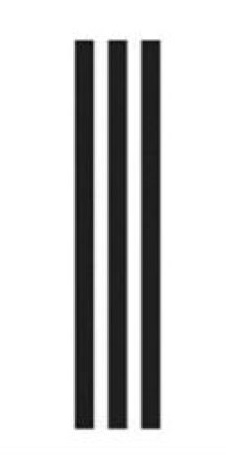
Adidas loses battle of the 3 stripes
 The case dates back to 2014 when, the famous German producer of sports goods, in order to extend the protection scope of its well know and already registered trademark with the sign of the three inclined strips, successfully registers the figurative trademark alongside the European Intellectual Property Office (EUIPO), composed by three equal strips and described in the application as three parallel equidistant stripes of identical width, applied on the product in any direction, on clothing, hats and shoes.
The case dates back to 2014 when, the famous German producer of sports goods, in order to extend the protection scope of its well know and already registered trademark with the sign of the three inclined strips, successfully registers the figurative trademark alongside the European Intellectual Property Office (EUIPO), composed by three equal strips and described in the application as three parallel equidistant stripes of identical width, applied on the product in any direction, on clothing, hats and shoes.
However, in 2016, due to a cancellation request filed by the Belgian company Shoe Branding Europe (company that has a longstanding dispute with Adidas and in the past has seen its figurative trademark application of two strips being rejected by similarities with the Adidas trademark, even with the strips inclined in the opposite direction), the EUIPO cancelled the trademark considering that it is lacked the necessary distinctive character, both intrinsic or acquired by use.
According to the EUIPO, Adidas was not able to demonstrate that the trademark had acquired a distinctive character throughout the European Union through its use and the German company appealed that decision to the General Court of the European Union, which denied the appeal.
Adidas needed to demonstrate that the figure of the three parallel strips inclined towards any direction, which it intended to register as a trademark, had acquired distinctiveness throughout the European Union because of its use by the company and that the consumers immediately associated the products identified by the three strips as coming from Adidas, being possible to distinguish them from the products of other companies.
The Luxembourg-based court has contradicted Adidas's arguments stating that it is not is not a pattern mark composed of a series of regularly repetitive elements, but an ordinary figurative mark. Furthermore, it is not possible to consider the different forms of use which deviate from the essential characteristics of the design of the mark (black lists against the white background), such as different colors combination.
Finally, the Court also maintained that Adidas did not prove that the mark in question had been used throughout the territory of the European Union and that it had acquired distinctive character throughout the territory through the use made of the design of the mark, arguing that the evidence produced by Adidas to a certain extent is only relevant for five Member States and cannot, in this particular case, be extrapolated to the whole territory of the European Union.
This case alerts for two issues to consider in the future:
1. Proof of use to demonstrate the acquisition of distinctive character
2. The European territorial delimitation for the acquisition of distinctive character
1. Proof of use to demonstrate the acquisition of distinctive character
One of the requirements for trademarks registration is their ability to distinguish themselves from other market competitors, however, the registration of a trademark consisting solely of generic or descriptive elements will not necessarily be impracticable provided that, the device, through its use, acquired sufficient distinctive character. Meaning, by its actual use on the market, a trademark which refers only to the species or characteristics of a product or service may become a reference capable of enabling the consumer to report those products or services to his business origin, and thus the essential distinctive function of trademarks.
Although a case-by-case assessment is always necessary, it is not enough for the interested party to indicate that the mark is used and it is essential to prove that the average consumer recognizes the mark as identifying the goods or services belonging to a single entity. Since it is essential that it is clearly shown that the figure of the mark to be registered is the figure that is used (and not different variations of the drawing), the use duration of the mark in question must also be demonstrated (the longer it is used, the greater the likelihood of having acquired the distinctive character), the degree of disclosure (marketing campaigns, advertisements, etc.), the volume of revenues associated with the mark (billing that reveals high profits may indicate that the public recognizes a particular brand as a trademark) or trade association advice and consumer surveys.
2. The European territorial delimitation for the acquisition of distinctive character
In relation to the territorial delimitation necessary to consider that a trademark has acquired distinctive character, a consideration will always be given to the specific case and it is not possible to delimit a closed criteria. However, in the present case, it would be necessary to prove that a trademark with the dimension of Adidas would have acquired the distinctive character in more than five countries. However, in situations to determine well know trademarks the Court of Justice of the European Union has already held that Austria (PAGO case) would be a substantial part of the territory of the European Union to be regarded as a well know trademark throughout the European Union.
Adidas may appeal this decision to the Court of Justice of the European Union within a period of two months and must provide further evidence that the three strips constitute a distinguishing sign of its products throughout Europe if it intends win the next judicial battle for the protection of this mark.
Currency Info
Final charges will be made in USD.
Currency conversion is for information purposes only and accuracy is not guaranteed. Overseas customers are encouraged to contact their bank or credit card provider for details on any additional fees these institutions may include for currency conversion.
Territory List
There are no results for your search.
- Africa
- Algeria
- Angola
- Benin
- Botswana
- Burkina Faso
- Burundi
- Cameroon
- Cape Verde
- Central African Republic
- Chad
- Comoros
- Congo (Republic)
- Côte d'Ivoire
- Democratic Republic of the Congo
- Djibouti
- Egypt
- Equatorial Guinea
- Eritrea
- Eswatini (Swaziland)
- Ethiopia
- Gabon
- Gambia
- Ghana
- Guinea
- Guinea-Bissau
- Kenya
- Lesotho
- Liberia
- Libya
- Madagascar
- Malawi
- Mali
- Mauritania
- Mauritius
- Mayotte
- Morocco
- Mozambique
- Namibia
- Niger
- Nigeria
- Réunion
- Rwanda
- Sao Tome and Principe
- Senegal
- Seychelles
- Sierra Leone
- Somalia
- South Africa
- South Sudan
- Sudan
- Tanzania (mainland)
- Togo
- Tunisia
- Uganda
- Western Sahara
- Zambia
- Zanzibar
- Zimbabwe
- Africa (OAPI)
- Africa (ARIPO)
- Other
- East Timor
- Macao
- Maldives
- Portugal
- European Patent (EPO)
- European Union Trademark (EUTM)
- International Trademark (Madrid System)
- Patent Cooperation Treaty (PCT)




